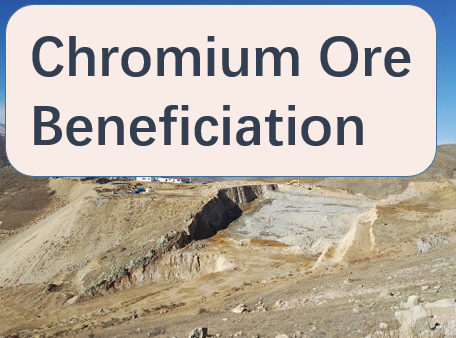Chromium Ore Beneficiation: Efficient Extraction from Mines to Concentrates
2025-01-22 Xinhai (1317)
2025-01-22 Xinhai (1317)
If you have any questions, please contact us through the following ways, we will give you more and better assistance!

Chromium is an important metal with unique physical and chemical properties, making it widely used in various industrial applications. The processing and extraction of chromium ore are crucial for ensuring the efficient utilization of chromium resources. This article will provide a detailed introduction to the main beneficiation processes for chromium ore and their applications.
Chromium ore primarily occurs in mafic-ultramafic igneous intrusive bodies and sometimes in metamorphic rocks. These ores typically appear in layered formations that can stretch for hundreds of kilometers in length but are only a few meters thick. Chromium ore is also commonly found in iron meteorites, often associated with silicates and troilite minerals.
Gravity separation is the primary process for chromium ore beneficiation, utilizing the density differences of minerals for separation. Common gravity separation equipment includes jigs, shaking tables, spiral classifiers, centrifugal concentrators, and spiral chutes. These devices separate heavy minerals from light minerals in chromium ore through gravitational action, thereby increasing the grade of chromium ore.
Magnetic separation is another important beneficiation method, especially suitable for treating weakly magnetic chromite. With the development of strong magnetic separation technology, magnetic separation has become an effective means of purifying chromium ore. The magnetic separation process is environmentally friendly and is widely used in various beneficiation plants. Typically, chromium ore is first subjected to gravity separation or screening and then sent to a magnetic separator for further purification.
Flotation or flocculation flotation processes can also be used for chromium ore beneficiation. These processes separate chromite from gangue minerals through the action of chemical reagents. Flotation is suitable for treating fine-grained chromite ores and can effectively increase the grade and recovery rate of chromium ore.、

The beneficiation process flow for rock chromium ore typically includes the following steps:
Crushing: The raw ore is first crushed by a jaw crusher.
Screening: The crushed ore is screened by a vibrating screen.
Grinding: The screened ore enters a ball mill for grinding.
Gravity Separation: The ground ore enters a jigging machine for gravity separation.
Magnetic Separation: The concentrate from gravity separation can be further purified by a magnetic separator.
Dewatering: The final concentrate is dewatered in preparation for the next process.
The beneficiation process flow for alluvial chromium ore is slightly different and mainly includes the following steps:
Feeding: The ore is fed into the beneficiation system through vibrating feeders, hoppers, belt feeders, etc.
Washing: Chromium ore washing machines are used to clean clay and slurry from the raw material.
Screening: The washed ore is screened through rotary screens or vibrating screens.
Primary Gravity Separation: Jigs or spiral chutes are used for primary separation.
Secondary Concentration: The concentrate enters a shaking table concentrator for final concentration.
Magnetic Upgrading: If a higher grade is required, a high-intensity magnetic separator can be used for further purification.
Environmental impact and economic efficiency are two important factors in chromium ore beneficiation. Gravity separation and magnetic separation processes are widely used due to their minimal environmental impact. In contrast, the flotation process requires strict control of chemical reagent usage to minimize potential environmental impacts. Additionally, selecting appropriate beneficiation equipment and processes can effectively reduce production costs and enhance economic benefits.
The choice of chromium ore beneficiation process depends on the physicochemical properties of the ore and specific industrial requirements. Gravity separation, magnetic separation, and flotation are the most widely used methods currently, each with its unique advantages and applicable scenarios. By designing a rational beneficiation process flow, the efficient extraction and utilization of chromium ore resources can be achieved while meeting environmental and economic requirements.